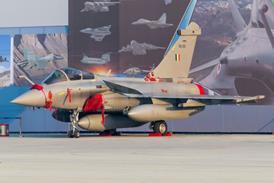The US Air Force (USAF) plans to flight test its boost-glide AGM-183A Air-Launched Rapid Response Weapon (ARRW) this week for the first time.
The service announced its plans late on 26 February, in a panel discussion at the Air Force Association’s Aerospace Warfare Symposium.

“We actually have hardware built and are getting ready for our first booster flight test next week,” said Brigadier General Heath Collins, programme executive officer for weapons and director of the USAF’s armament directorate. “There’s real hardware coming. We’re also getting ready to transition into production within about a year on that programme.”
The service plans to have an operational weapon on hand by 2022, it says. The USAF has pushed to field ARRW ahead of air-breathing hypersonic missiles because the boost-glide missile is easier to develop and manufacture. Lockheed Martin is the prime contractor on the ARRW programme.
Nonetheless, the service sees a lot of promise in air-breathing hypersonic missiles, such as the in-development Hypersonic Attack Cruise Missile (HACM), a missile propelled by an air-breathing scramjet, says Major General Andrew Gebara, director of strategic plans, programmes and requirements for Global Strike Command.
Air-breathing hypersonic missiles can be made smaller because instead of having to carry oxidizer, as rocket-powered boost-glide missiles must, their scramjet engines skim oxygen out of the atmosphere. And, smaller missiles have practical applications for fielding on aircraft, says Gebara.
“I can put four ARRWs on a bomber, but I could put 20 HACMs on a bomber, if done right, and maybe more if I have different pylons,” he says.
The USAF has previously noted that air-breathing hypersonic cruise missiles also fly closer to the ground. Because of that the curvature of the earth hides the weapon’s approach until the last few moments before impact, making the missile difficult to evade or shoot down.


























